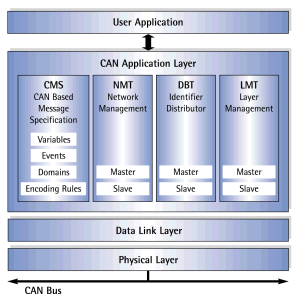CAL (CAN Application Layer) was specified as one of the first work items of CAN-in-Automation (CiA) and was published in 1993 as layer 7 standard CiA DS 201-207.
The protocol offers an application-independent, object-oriented environment for the implementation of CAN-based distributed systems. It provides objects and services for communication, identifier distribution, network and layer management. Main application areas of CAL are CAN-based distributed systems which do not require configurability and standardized device modeling. Therefore in the CAL specification only general communication procedures are defined as they are required in distributed systems.
CAL provides objects, protocols and services for the event driven or requested transmission of CAN messages and for the transmission of larger data blocks between CAN devices. Furthermore CAL offers mechanisms for the automatic distribution of CAN identifiers and for the initialization and monitoring of nodes.

CANopen and DeviceNet specify also the structure and parts of the application itself mainly by fixed access methods for data exchange and data representation. In contrast to these protocols CAL doesn't define data contents or specific communication objects which a certain device has to provide or which are expected by the system. So the user has the possibility to adapt the communication system exactly to the requirements of his application or system and not the other way round. Using a communication and device profile like CANopen or DeviceNet could mean higher resource overhead for the realized application. Therefore CAL is suitable for the realization of specific system solutions like medical systems or measuring systems as well as for the realization of closed control systems with decentral intelligent units like machine control systems (machine bus). CAL allows the realization of systems with complex communication relations between devices in a system. These systems can be installed without any configuration effort.
First versions of the CAL software have been available already in 1993. Until today, the software was successfully in use in numerous applications. Hence the software achieved a high and stable development state.
